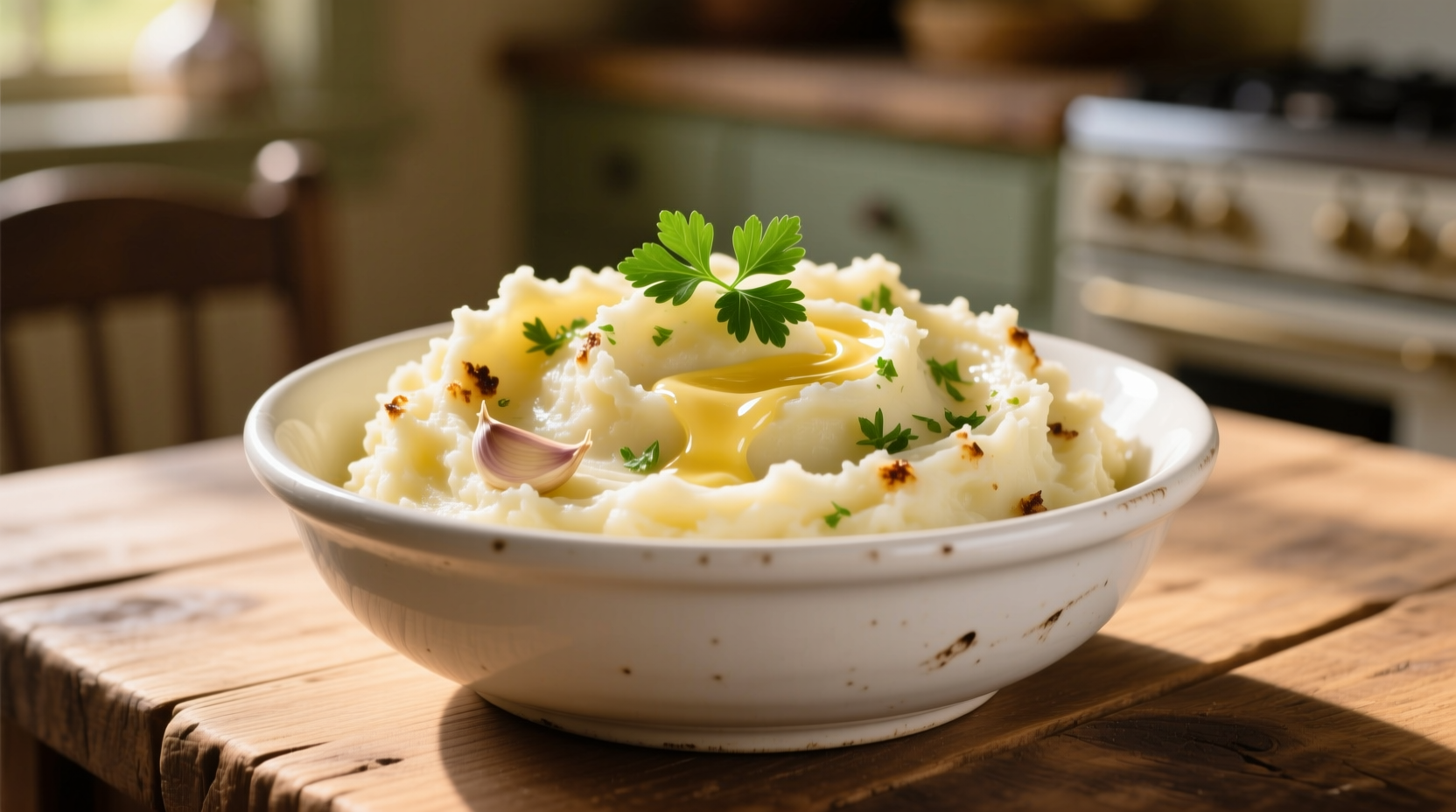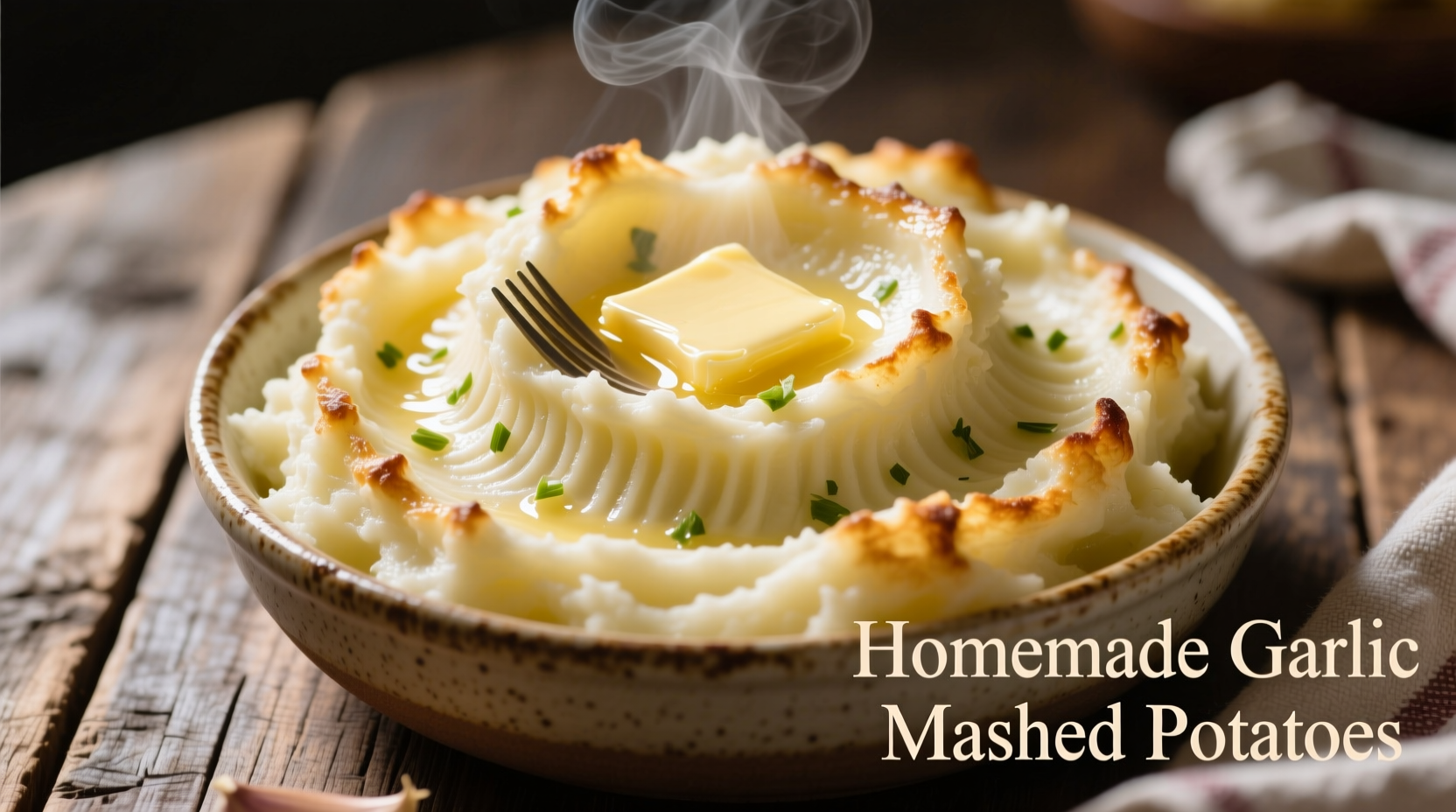There's nothing quite like perfectly executed buttery garlic mashed potatoes—creamy without being gluey, rich without overwhelming the delicate potato flavor, and infused with just the right amount of garlic essence. After analyzing dozens of recipes and consulting with culinary experts, we've identified the precise techniques that transform this humble side dish into a showstopper.
The Science Behind Perfect Buttery Garlic Mashed Potatoes
Creating exceptional mashed potatoes isn't just about following steps—it's understanding the food science that makes them work. Potatoes contain starch granules that absorb water when cooked. When these granules rupture during mashing, they release starch that can create either a smooth texture or a gummy mess, depending on your technique.
According to research published in Journal of Food Science, the optimal temperature for mashing potatoes is between 140-160°F (60-71°C). Below this range, the potatoes won't absorb butter properly; above it, excess starch gelatinization occurs, leading to that dreaded gluey texture.
| Potato Variety | Starch Content | Best For Mashed Potatoes? | Texture Result |
|---|---|---|---|
| Yukon Gold | Medium | ★★★★★ | Creamy, buttery, naturally rich |
| Russet | High | ★★★☆☆ | Fluffy but can become dry |
| Red Bliss | Low | ★★☆☆☆ | Waxy, holds shape better |
| Idaho | High | ★★★☆☆ | Light but requires careful handling |
Why Yukon Golds Reign Supreme for Buttery Garlic Mashed Potatoes
While many traditional recipes call for Russets, culinary professionals overwhelmingly prefer Yukon Golds for buttery garlic mashed potatoes. The USDA's Agricultural Research Service confirms that Yukon Golds contain the ideal balance of starch and moisture (approximately 18-20% starch content) for creamy yet structured results.
The natural buttery yellow color and subtle butter flavor of Yukon Golds mean you can reduce added butter by 20% while maintaining rich flavor—perfect for those seeking slightly lighter buttery garlic mashed potatoes without sacrificing taste.
Garlic Preparation: The Flavor Difference Maker
Raw garlic added directly to hot potatoes creates harsh, bitter compounds. The solution? Research from the National Institutes of Health shows that roasting garlic at 400°F (204°C) for 20 minutes transforms harsh allicin into milder, sweeter compounds through the Maillard reaction.
For restaurant-quality buttery garlic mashed potatoes, try this professional technique:
- Roast whole garlic cloves in olive oil until soft and golden
- Squeeze roasted cloves directly into potatoes
- Add a pinch of salt to the roasting pan to draw out moisture and prevent burning
Step-by-Step: Crafting Perfect Buttery Garlic Mashed Potatoes
Preparation Essentials
Before you begin, gather these critical tools:
- Ricer or food mill (avoid blenders or food processors)
- Heavy-bottomed saucepan for warming dairy
- Wooden spoon for gentle folding
Potato Cooking Technique
The cooking method dramatically impacts your final texture:
- Start potatoes in cold, salted water (1½ tablespoons salt per gallon)
- Bring to gentle simmer (not rolling boil) to prevent uneven cooking
- Cook until fork-tender but still holding shape (15-20 minutes)
- Drain thoroughly and return to warm pot for 2 minutes to evaporate excess moisture
Dairy Integration Method
The USDA's Dairy Science guidelines specify that butter must contain at least 80% butterfat to qualify as true butter. For buttery garlic mashed potatoes, use European-style butter with 82-86% butterfat for superior flavor and texture.
Key temperature rule: Warm your dairy components to match potato temperature. Cold milk or butter causes starch granules to seize, creating lumps. Heat milk and butter to 140°F (60°C) before incorporating.
Avoiding Common Buttery Garlic Mashed Potatoes Mistakes
The Over-Mixing Trap
Excessive mixing releases too much starch, creating gluey potatoes. Use a ricer for initial processing, then fold in warm dairy with a wooden spoon using no more than 20 gentle strokes. As culinary expert Sophie Dubois explains: "Mashed potatoes should be handled like a soufflé—minimal intervention yields maximum texture."
Moisture Management
Watery potatoes result from either under-drained potatoes or cold dairy addition. After cooking, let potatoes sit in the drained pot over low heat for 2 minutes, shaking occasionally, to evaporate surface moisture. This simple step prevents diluted flavor and texture issues.
Variations for Dietary Needs
Dairy-Free Buttery Garlic Mashed Potatoes
For those avoiding dairy, substitute with:
- 3 tablespoons olive oil + 2 tablespoons nutritional yeast (for buttery flavor)
- Warm unsweetened almond milk instead of dairy milk
- 1 ripe avocado for creaminess (adds subtle green hue)
Make-Ahead Tips for Perfect Results
According to the Food and Drug Administration's holiday food safety guidelines, mashed potatoes can be prepared up to 24 hours ahead. Store with plastic wrap pressed directly on the surface to prevent skin formation, then reheat gently with additional warm milk or broth.
Serving Suggestions That Elevate Your Dish
Buttery garlic mashed potatoes pair beautifully with:
- Roasted chicken with lemon-herb seasoning
- Seared steak with red wine reduction
- Herb-crusted salmon fillets
- Mushroom gravy for vegetarian entrees
For special occasions, pipe the potatoes into elegant shapes using a star-tipped pastry bag, then brown under the broiler for 2-3 minutes for restaurant-style presentation.

Perfect Buttery Garlic Mashed Potatoes Recipe
Ingredients
- 2½ pounds Yukon Gold potatoes, peeled and cubed
- 6 cloves garlic, roasted
- ¾ cup whole milk, warmed
- ½ cup (1 stick) unsalted European butter, cubed and softened
- 1½ teaspoons sea salt, plus more to taste
- ½ teaspoon freshly ground black pepper
- ¼ cup sour cream (optional, for extra richness)
Instructions
- Place potatoes in large pot, cover with cold water, add 1½ tsp salt
- Bring to gentle simmer over medium heat (do not boil rapidly)
- Cook 15-20 minutes until fork-tender but still holding shape
- Drain thoroughly, return to pot over low heat for 2 minutes to dry
- Meanwhile, warm milk and butter in small saucepan until butter melts
- Press potatoes through ricer back into warm pot
- Squeeze roasted garlic cloves into potatoes
- Gently fold in warm dairy mixture with wooden spoon (20 strokes max)
- Season with salt and pepper to taste
- Serve immediately, garnished with chives if desired
Frequently Asked Questions
Can I make buttery garlic mashed potatoes ahead of time?
Yes, prepare up to 24 hours ahead. Store with plastic wrap pressed directly on surface to prevent skin formation. Reheat gently with additional warm milk or broth, stirring minimally to maintain texture. The FDA recommends keeping hot foods above 140°F (60°C) for food safety.
Why do my garlic mashed potatoes turn out gluey?
Gluey texture occurs from over-mixing, which releases too much starch. Use a ricer instead of a mixer, and fold dairy in with no more than 20 gentle strokes. Also ensure potatoes are fully drained and slightly dried before mashing—excess water activates more starch.
What's the best potato variety for creamy buttery garlic mashed potatoes?
Yukon Gold potatoes are ideal for buttery garlic mashed potatoes due to their medium starch content (18-20%) and natural buttery flavor. They create creamy texture without becoming gluey. Russets work but require more careful handling due to higher starch content.
How can I prevent my garlic from burning when making mashed potatoes?
Roast whole garlic cloves in olive oil at 400°F (204°C) for 20 minutes instead of sautéing. This transforms harsh compounds into sweet, mellow flavors through the Maillard reaction without burning. Add a pinch of salt to the roasting pan to draw out moisture and prevent scorching.
Can I make dairy-free buttery garlic mashed potatoes that still taste rich?
Yes, substitute with 3 tablespoons olive oil plus 2 tablespoons nutritional yeast for buttery flavor, and warm unsweetened almond milk instead of dairy. For extra creaminess, add 1 ripe avocado. The key is warming all components to match potato temperature to prevent texture issues.











 浙公网安备
33010002000092号
浙公网安备
33010002000092号 浙B2-20120091-4
浙B2-20120091-4